
Jasmine is a genus of shrubs and vines in the olive family (Oleaceae). It contains around 200 species native to tropical and warm temperate regions of Eurasia and Oceania. Jasmines are widely cultivated for the characteristic fragrance of their flowers. A number of unrelated plants contain the word "jasmine" in their common names.

Philadelphus (mock-orange) is a genus of about 60 species of shrubs from 3–20 ft tall, native to North America, Central America, Asia and (locally) in southeast Europe.
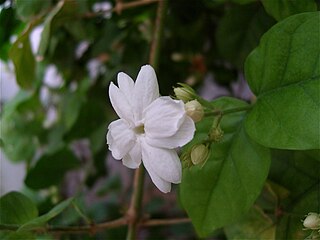
Jasminum sambac is a species of jasmine native to tropical Asia, from the Indian subcontinent to Southeast Asia. It is cultivated in many places, especially across much of South and Southeast Asia. It is naturalised in many scattered locales: Mauritius, Madagascar, the Maldives, Christmas Island, Chiapas, Central America, southern Florida, the Bahamas, Cuba, Hispaniola, Jamaica, Puerto Rico, and the Lesser Antilles.

Jasminum nudiflorum, the winter jasmine, is a slender, deciduous shrub native to China. The flower's blossoming peaks right after winter, which is why it is also named Yingchun (迎春) in Chinese, which means "the flower that welcomes Spring". It is widely cultivated as an ornamental and is reportedly naturalized in France and in scattered locations in the United States.
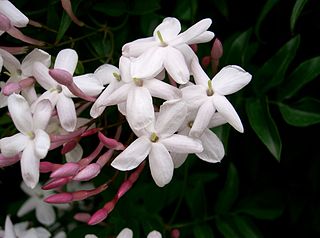
Jasminum polyanthum, the many-flowered jasmine or pink jasmine, is a species of flowering plant in the olive family Oleaceae, native to China and Myanmar. A strong evergreen twining climber, it is especially noted for its abundant, highly fragrant pink to white flowers.

Jasminium dichotomum, the Gold Coast jasmine, is a species of jasmine, in the family Oleaceae. It is an evergreen climber which grows as a rambling shrub or woody vine. The flowers are quite fragrant and open at night, coloured pink when budding then white; these appear at the leaf axils in cluster. It blooms year round. The leaves are opposite. The fleshy fruit is small.

Jasminum grandiflorum, also known variously as the Spanish jasmine, Royal jasmine, Catalan jasmine, among others, is a species of jasmine native to South Asia, the Arabian peninsula, East and Northeast Africa and the Yunnan and Sichuan regions of China. The species is widely cultivated and is reportedly naturalized in Guinea, the Maldive Islands, Mauritius, Réunion, Java, the Cook Islands, Chiapas, Central America, and the Caribbean.It is closely related to, and sometimes treated as merely a form of, Jasminum officinale. The plant is known as "saman pichcha" or "pichcha" in Sri Lanka.
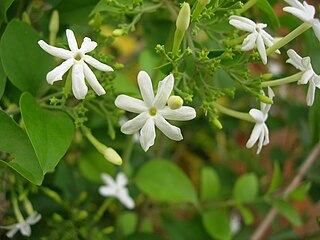
Jasmine is considered the queen of flowers and is called the "Belle of India" or the "Queen of fragrance" as it is exquisitely scented to soothe and refresh. In different parts of India it is called by different names—Mogra, Motia, Chameli, Malli puvvu, Jaati, Mallige, Juhi, Mogra or Moonlight in the grove. It is reported that there are 300 varieties of jasmine. It is also stated that jasmine crossed the seas—from Asia to Europe, landing first along the Mediterranean Sea, conquering Greece and Turkey, reaching Western Europe through Spain, then France and Italy and finally landing in England in the latter part of the 17th century..

Jasminum officinale, known as the common jasmine or simply jasmine, is a species of flowering plant in the olive family Oleaceae. It is native to the Caucasus, northern Iran, Afghanistan, Pakistan, the Himalayas, Tajikistan, India, Nepal and western China. The species is also widely cultivated in many places, and is reportedly naturalized in Spain, France, Italy, Portugal, Romania, Croatia, Bosnia and Herzegovina, Montenegro, Serbia, Algeria, Florida and the West Indies.
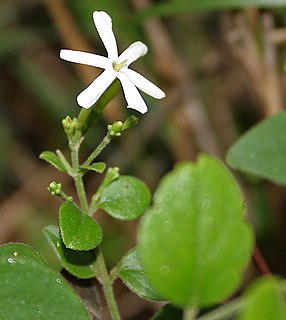
Jasminum auriculatum is a species of jasmine, in the family Oleaceae. It is found in India, Nepal, Sri Lanka, Bhutan and the Andaman Islands. Due to essential oil contained in the flowers, it cultivated commercially in India and Thailand. It is used for decorative purposes and festivals in India. It is commonly called "JUI"(ଯୁଇ, জুই) in India in Odia and Bengali languages.
Jasminium abyssinicum is a species of jasmine, in the family Oleaceae.

Jasminum multiflorum, commonly known as star jasmine, is a species of jasmine, in the family Oleaceae.

Jasminum angulare, the wild jasmine or angular jasmine, is a species of flowering plant in the family Oleaceae that is indigenous to South Africa.

Jasminum humile, the Italian jasmine or yellow jasmine, is a species of flowering plant in the family Oleaceae, native to Afghanistan, Tajikistan, Pakistan, Nepal, Burma (Myanmar), the Himalayas and south west China. The species is widely cultivated and reportedly naturalized in Greece, Sicily and the former Yugoslavia.

Jasminum tortuosum is a species of jasmine native to South Africa. It is generally found twining high into the trees of forests in southwestern part of Cape Province, but also may scramble where there is little vertical space. It has angular branches off its main stem, and its flowers usually have five white petals each. The specific epithet (tortuosum) is from Latin, describing something that is winding or very twisted.
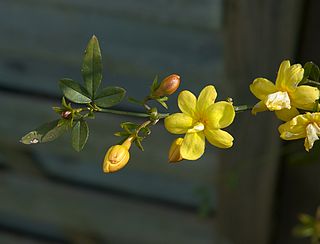
Jasminum mesnyi, the primrose jasmine or Japanese jasmine, is a species of flowering plant in the family Oleaceae, native to Vietnam and southern China. It is also reportedly naturalized in Mexico, Honduras and parts of the southern United States.

Jasminum azoricum, the lemon-scented jasmine, is a species of flowering plant in the olive family. It is an evergreen twining vine native to the Portuguese island of Madeira. The compound leaves consist of 3 bright green leaflets. The fragrant white star-shaped flowers appear in panicles from the leaf axils in summer, evolving from deep pink buds.

Jasminum malabaricum, the Malabar jasmine or wild jasmine, is a species of flowering plant in the family Oleaceae, native to southern parts of India, and Sri Lanka.

Jasminum angustifolium, the wild jasmine, is a species of jasmine native to India, Sri Lanka and the Andaman Islands. It is a climbing shrub with a smooth stem and minutely pubescent branchlets. The flowers are approximately 1 inch in diameter, and resemble a star with 7 or 8 narrow petals, flowering between June and August.


















